
94% of researchers rate our articles as excellent or good
Learn more about the work of our research integrity team to safeguard the quality of each article we publish.
Find out more
ORIGINAL RESEARCH article
Front. Mar. Sci., 24 November 2022
Sec. Marine Affairs and Policy
Volume 9 - 2022 | https://doi.org/10.3389/fmars.2022.940803
This article is part of the Research TopicNew Frontiers of Marine Governance in the Ocean DecadeView all 12 articles
The aim of this study is to assess marine-protected areas’ (MPAs) effectiveness in the protection of marine mammals. With this purpose, the study analyzed the long-term population trend of four different species of marine mammals, geographically placed in distant MPAs. In addition, matching biophysical and governance indicators were identified in order to relate the different management approaches to the biological effectiveness or ineffectiveness of the respective MPA. The results show population recovery trends, providing empirical evidence that suggests the effectiveness of area-based protection measures in marine mammals. Moreover, a parallelism between the governance indicators and the biophysical ones supports that biological and management effectiveness are interrelated. On this basis, the biophysical indicator of human impact was discussed to be deeply related to the precautionary principle, which appears less efficient than the adaptive management. Finally, this study highlights the necessity to better monitor the effectiveness of MPAs in order to avoid paper parks and suggest future recommendations.
Nowadays, the updated list of marine mammals consists of 132 currently living species, placed in four different taxonomic groups including cetaceans (whales, dolphins, and porpoises), pinnipeds (seals, sea lions, and walruses), sirenians (manatees and dugongs), and marine fissipeds (polar bears and sea otters). Nonetheless, the proportion differs considerably from one taxonomic group to another; cetaceans represent 70%, pinnipeds 25%, sirenians 3%, and marine fissipeds 2% (Committee on Taxonomy, 2021), (NOAA, 2019b).
Marine mammals are a very diverse group. First of all, the degree of adaptation to the aquatic environment of each taxonomic group depends on the proportion of time spent in water (Hoelzel, 2009). Therefore, Cetaceans, which spend their entire lives in water, have extreme aquatic adaptations and a great diversity of morphological forms, whereas the sea otter and the polar bear are less adapted to the aquatic lifestyle due to the fact that they spent most of their lifetime on ice or land along the shore (Würsig, 2019).
Marine mammals’ ecosystems are also very diverse (marine, terrestrial, or both) as is the variety in their ecological roles (herbivores, filter feeders, and top predators).
Overall, there are considerable challenges in order to protect this heterogenous group of species. Hence, in most cases, the development and implementation of management approaches must be very dynamic due to the long list of threats marine mammals are exposed to, often requiring international collaborations and agreements.
Direct threats are the proximate human activities or processes that have impacted, are impacting, or may impact the status of the taxon being assessed (e.g., unsustainable fishing or logging, agriculture, and housing developments) (IUCN, 2021). Marine mammal species worldwide are known to be impacted by several anthropogenic activities, most of them being addressed as direct threats.Marine mammal threats can be classified into seven different categories: incidental catch and fishing gear interactions, direct harvesting, pollution, traffic, pathogens and introduced species, resource depletion, and ocean-physics alteration. All of them have direct human activity as a threat source aside from ocean-physics alteration, which is not directly due to human activity but to external drivers like, e.g.,climate change (Avila et al, 2018).
As can be seen in Figure 1, the relative impact of different threat types is variable across different taxa. However, overall, in terms of marine mammal threats, incidental catch is the most common threat category affecting 112 species followed by pollution (99 species), direct harvesting (89 species), and traffic (86 species).
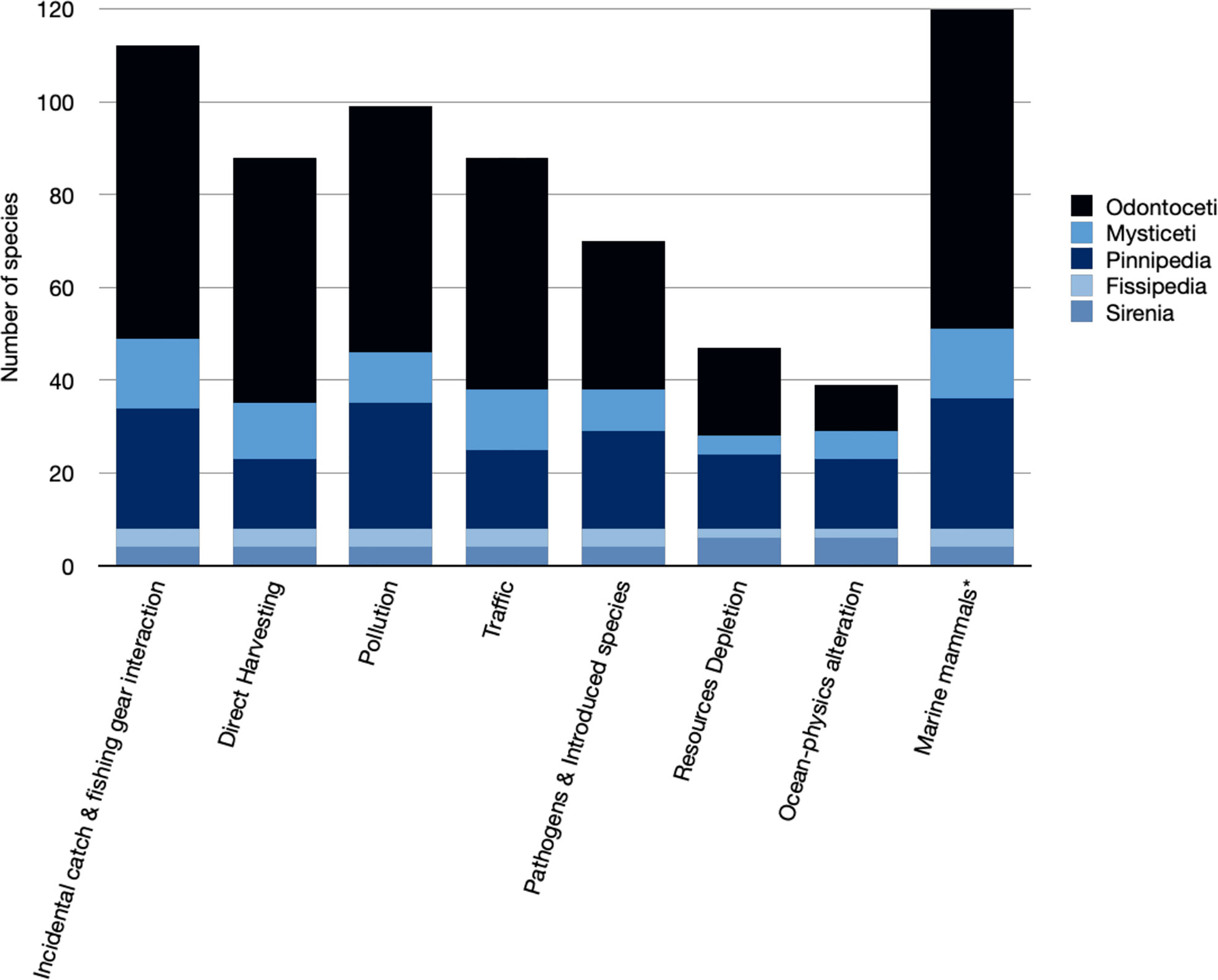
Figure 1 Number of species of each taxon documented to be affected (between 1991 and 2016) by different threat categories. Source: Adapted from Avila et al, 2018.
Each of these four major threats is associated to several threat attributes; the ones having more impact in marine mammals are by-catch (associated to incidental catch) followed by wastes (associated to pollution) and direct harvesting (associated to commercial activity) (Avila et al, 2018).
Numerous treaties and conventions all over the world have established the protection and preservation of the marine environment. Some of the aforementioned can be related to marine mammals even though their application and purpose are more general, while others have been specifically created for the protection of these animals.
For instance, the purpose of the Convention on International Trade in Endangered Species of Wild Fauna and Flora (CITES; Washington, 1973) entails the protection of marine mammals without them being the primary objective.
Moreover, other conventions have also provided broad marine protection, for example, the Convention on the Conservation of Migratory Species of Wild Animals placed in Bonn in 1979, recognizing the threats migratory species face during their travels (CMS; United Nations Convention on the Conservation of Migratory Species of Wild Animals (Bonn). Additional examples are the United Nations Convention on the Law of the Sea United Nations Convention on the Law of the Sea, (Montego Bay)) or the United Nations Convention on Biological Diversity (CBD; United Nations Convention on Biological Diversity, 1992).
The aforementioned conventions constitute a legal framework that enables the protection of marine mammals. However, more specific treaties provide these species with a higher level of protection. For instance, the International Convention for the Regulation of Whaling (ICRW, Washington, 1946) was created with the specific purpose of sustainably managing whale stocks. The convention emphasized the need to prevent the further overfishing of this species, aiming to ensure the natural increases of the whale stocks that will allow the future exploitation of the whales, once regulated, without endangering the natural resource. While the original signatories of the Whaling Convention were 15 whaling countries, the parties now number 89 states. Most of the countries that previously engaged in whaling have ceased this activity and actually oppose to whaling for commercial purposes (Scovazzi, 2016).
Each of these conventions and treaties mentioned above constitutes a legal framework that enables the protection of marine mammals. However, even the ones specifically created for the protection of these animals are lacking enforcement. For instance, from the perspective of international law, any country that has not signed the whaling convention can still hunt these animals in the same places where others (the ones who signed up the convention) are protecting them. Therefore, conventions represent a first step toward the protection of marine mammals; however, the global legal circumstances are significantly complex.
On the contrary, marine-protected areas (MPAs) are more likely to achieve the intended goals of protection toward marine mammals. Taking into account that most MPAs are placed in territorial waters, once they are proposed, they come with its own country legal framework and own placed-based objectives. Afterward, once the MPA is declared, its legal framework will be part of the national legislation. Hence, the government would be able to enforce these rules and protect the marine mammals under the national law. Once MPAs are declared, they are backed by national legislation, which allows governments to enforce the obligations at a more local scale.
Therefore, careful consideration should be given to whether MPAs are effective or not in the protection of marine mammals since MPAs are the most concrete and operative part of these international efforts. Contrary to conventions and treaties, these ones have already acquired a more legally binding nature. However, cetaceans are highly mobile animals, and the ranges of most populations are sometimes too large for this to be practicable. On the other hand, when only a portion of a cetacean population’s range can be included within a protected area, there is obvious merit in selecting and designing MPAs in habitats that bear special importance for the species to be protected, such as key breeding and feeding areas (Sellheim, 2020). Consequently, the aims of this study are to
1.Assess the effectiveness of MPAs in the protection of marine mammals
2.Provide lessons learned and future recommendations, for instance, the necessity of MPA effectiveness evaluation or the benefits of having a more adaptive management
According to the International Union for Conservation of Nature (IUCN) (IUCN-WCPA, 2008, as cited in Horigue et al, 2012) and Kelleher (1999), MPAs are the designated areas of intertidal or subtidal terrain, with a degree of protection and therefore where human activities are more regulated or even banned.
In the following sections, several existing MPAs around the world are going to be analyzed through a very extensive literature review to obtain information on cetacean habitat protection. In order to study the greatest variety of MPA approaches to marine mammal’s protection, the selection of the case studies does not cover a specific region.
Extended research was carried out to choose several representative case studies of protection of marine mammals. This study has chosen the following criteria for the selection of case studies:
1.The presence of marine mammals and identification of key species of concern
2.Defined MPA goals in view of marine mammals
3.Previous threats to marine mammals in the area actually covered by the MPA
4.A minimum of 10 years since MPA establishment
5.The existence of qualitative data on marine mammal population trends within the area
The first and second criteria were developed to assure the importance of marine mammalians in the protection of the area. The third criterion was established to capture an eventual changing trend in the populations of marine animals after MPA designation.
The effects of an MPA are not immediate but become eventually apparent several years after its implementation (Selig and Bruno, 2010). The criterion of 10 years was not arbitrary, but Two interrelated aspects were considered: the MPA management plan established the frequency of revision and the required time to detect change in the trend of a population of marine mammals.
Concerning long-term population trends, it was established by the minimum required period under the IUCN criteria for assessing population decline. In cases where data do not cover three generations, 10 years were kept as the minimum required period (IUCN, 2010 as cited in Magera et al., 2013).
Regarding the response variable, according to the guideline of “Outline for Management Plan for National Nature Reserves,” the management plan objective is usually specified for a period of 10 years and therefore, for each MPA, the management plan is rewritten after 10 years (North-East Asian Subregional Programme for Environmental Cooperation (NEASPEC), 2021). Both criteria were fulfilled with the same period of time; hence, the minimum since the MPA establishment was determined to be 10 years.
Lastly, the fifth criterion was developed to conduct a high-quality study of the MPA effectiveness for marine mammals based on long-term reliable data.
In order to decide which MPAs were suitable for this study, a selection procedure was developed applying the five criteria outlined above. Bibliographic research was carried out through the directory of worldwide MPAs that feature or include marine mammals’ habitat (Cetaceanhabitat.org, 2022). Consequently, 20 MPAs were obtained constantly endeavoring the representativeness of different parts of the world as can be seen in Annex 1.
Subsequently, extensive research was carried out to ensure that the aforementioned criteria were fulfilled. For this purpose, the official IUCN website for protected areas was used as source of information to retrieve the status year of the MPA (Explore the World's Protected Areas, 2022). If one of the criteria was not fulfilled, the rest of them were not applied. Only four MPAs fulfilled all the criteria above stated and were therefore selected as case studies (Annex 1).
Goals related to the protection of marine mammals in each of the selected MPAs were grouped. Relevant indicators were chosen to address the overall value of these goals, following Pomeroy et al. (2004).
The basis of this study was to use variations in the population trend of target species to assess MPA effectiveness in the protection of marine mammals; hence, indicator number 1 (focal species abundance) was scored.
The evaluation of the governance goals was undertaken in order to assess management effectiveness and to draw lessons from those MPA experiences. Indicator number 2 (area under no or reduced human impact), indicator number 3 (existence of a decision-making management body), indicator number 4 (existence and adoption of a management plan), and indicator number 5 (existence and adequacy of enabling legislation) were evaluated.These indicators are illustrated in Table 1.
Furthermore, the results of the biophysical indicator 1 were used as evidence to demonstrate biological effectiveness (or ineffectiveness) depending on the variations of the population trends. Finally, once the effectiveness of each study case was analyzed, the overall effectiveness of MP:As in the protection of marine mammals was assessed through discussion.
Lastly, a comparison between the four case studies was held, in order to relate the effectiveness of the MPA (quantified by indicators 1 and 2) to MPA governance (indicators 3–5). The obtained results were placed in a broader perspective to learn lessons and provide future recommendations.
Applying the methodology described above, four case studies from different parts of the world were selected. It can be noted that the unequal distribution of resources between developed and developing countries acts as a criterion itself. This can be clearly seen in Annex 1, where most of the cases from undeveloped countries do not fulfill the aforementioned criteria. Consequently, the four MPAs chosen belong to developed countries and are placed in different parts of the world.
Firstly, The Wadden Sea is placed along the coasts of Denmark, Germany, and the Netherlands. Secondly, The Banks Peninsula is on the East coast of the South Island of New Zealand. Humpback Whale National Marine Sanctuary is located in Hawaii, and Melville bay is in Greenland.
The MPAs were divided into two oceans; two MPAs were located on the North Atlantic, whereas the other two were placed on the Pacific Ocean. All of them were separated by enormous distances.
In the following sections, each case study is going to be characterized, the population trends of the focal species as shown, and the indicators values are assessed.
The Trilateral Wadden Sea Cooperation (TWSC) between Denmark, Germany, and the Netherlands (see Figure 2) was established in 1978 (Common Wadden Sea Secretariat (CWSS), 2021). In 1990 (entered in force 1 year later), the Agreement on the Conservation of Seals in the Wadden Sea (WSSA) was concluded to promote close cooperation among the Parties (Denmark Germany, Netherlands). It aimed to achieve and maintain a favorable conservation status for the harbor seal population, which was a particularly critical issue in 1988 (Common Wadden Sea Secretariat, 2016). The state of declaration of the Wadden Sea Plan was adopted in 1997 (Common Wadden Sea Secretariat, 1997) and updated in 2010 (Common Wadden Sea Secretariat (CWSS), 2010). Therefore, the Wadden sea was designated as a conservation area in 2009, but conservation measures were taken since 1978 and the target species had been protected since 1991.
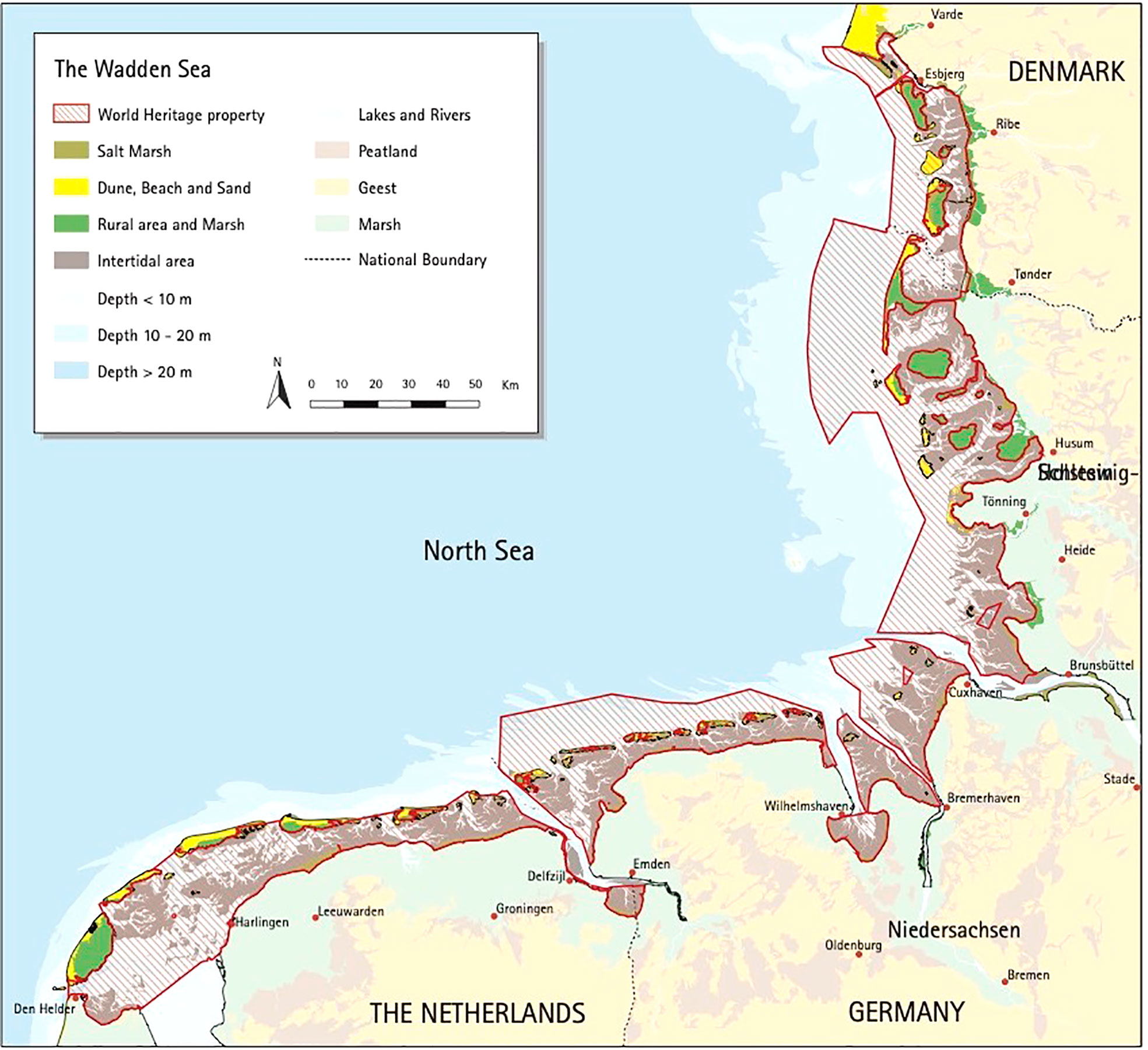
Figure 2 Map of the Wadden Sea. Source: UNESCO, World Heritage Center, 2014.
Harbor seals were hunted in the Wadden Sea until 1977, critically decimating the population (Jensen et al., 2017). In 1974, the population counted only 3,551 animals. From 1979, the population presented a recovering trend until 1988 when the epizootic of Phocine Distemper Virus (PDV) reduced the population by 57% (Figure 3) (Reijnders et al., 2010). After the PDV epizootic, the harbor seal population recovered, reaching pre-epizootic levels by 1995 and more than doubling its levels by 2001 (Jensen et al., 2017). In 2002, a second PDV epidemic decimated the population, in this case by 50% (Reijnders et al., 2010). Afterward, the population grew again until 2014. Lastly, by 2017, the total population of harbor seals in the Wadden Sea numbered approximately 38,126 animals (Jensen et al., 2017).

Figure 3 Harbor seal count in the Wadden Sea 1975–2017. No total number available for 1988, 2022, and 2016 due to Phocine Distemper Virus (PDV) or weather. Source: Jensen et al., 2017.
Some activities, such as mining and mineral oil prospecting, are considered to have such a high impact that they are incompatible with biodiversity conservation and should not occur on any MPA (Grorud-Colvert et al., 2021). No other human impact was evaluated since mining was allowed, and MPAs were already classified as incompatible with conservation.
There is currently no oil extraction in the Dutch Wadden Sea, and according to the Statutory Order on the Nature Reserve Wadden Sea, the exploitation of gas and oil in the Danish part of the conservation area is prohibited. However, Mittelplate 1, Germany’s largest oil field, is situated within the core of the National Park. Since 1987, the field has been exploited. The infrastructure of the production island was also developed and located on the southern edge of the Wadden Sea (Baer and Nehls, 2017).
In the case of the Wadden Sea, there is a very well-defined decision-making management body. The Trilateral Wadden Sea Cooperation comprises of two levels of decision-making: the Trilateral Governmental Council and the Wadden Sea Board (WSB). They are supported by the Common Wadden Sea Secretariat (CWSS) as the coordinating body and first contact point, advisors from Non Governmental Organizations (NGOs), and task groups as well as expert networking groups (Waddensea-worldheritage.org, 2021a).
An analysis of the existent management plan was carried out in order to determine the completeness of the plan. Since the Wadden Sea Plan (Common Wadden Sea Secretariat, 2010) is complete and, at the same time, enforceable, it can be concluded that the MPA is being guided by goals and objectives to achieve certain outcomes and that there is a basic strategy to achieve these goals and objectives (Pomeroy et al, 2004).
A legal overview was conducted to determine the existence of legislation, its compatibility, and appropriateness toward the MPA. As a result of the analysis, it was obtained that there are numerous laws of different levels supporting the MPA; International laws (Convention on the Conservation of Migratory Species of Wild Animals, Ramsar Convention, Agreement on the Conservation of Seals in the Wadden Sea…), EU legislation (Habitat Directive, Natura 2000…), and national protection (Statutory Order on the Wadden Sea Nature and Wildlife Reserve, Federal Nature Conservation Act…) (Waddensea-worldheritage.org, 2021b). Therefore, the existence of adequate legislation has been determined to support the management of the MPA.
The Banks Peninsula Marine Mammal Sanctuary is the first marine mammal sanctuary created in New Zealand. It was established in 1988 to order to protect the endangered Hector’s dolphin (Cephalorhynchus hectori) from bycatch in set nets. When the sanctuary was first created, it covered an area of 1,140 km². Nowadays, the Banks Peninsula Marine Mammal Sanctuary encompasses a total area of approximately 14,310 km², which can be seen in Figure 4 (Doc.govt.nz, 2021).
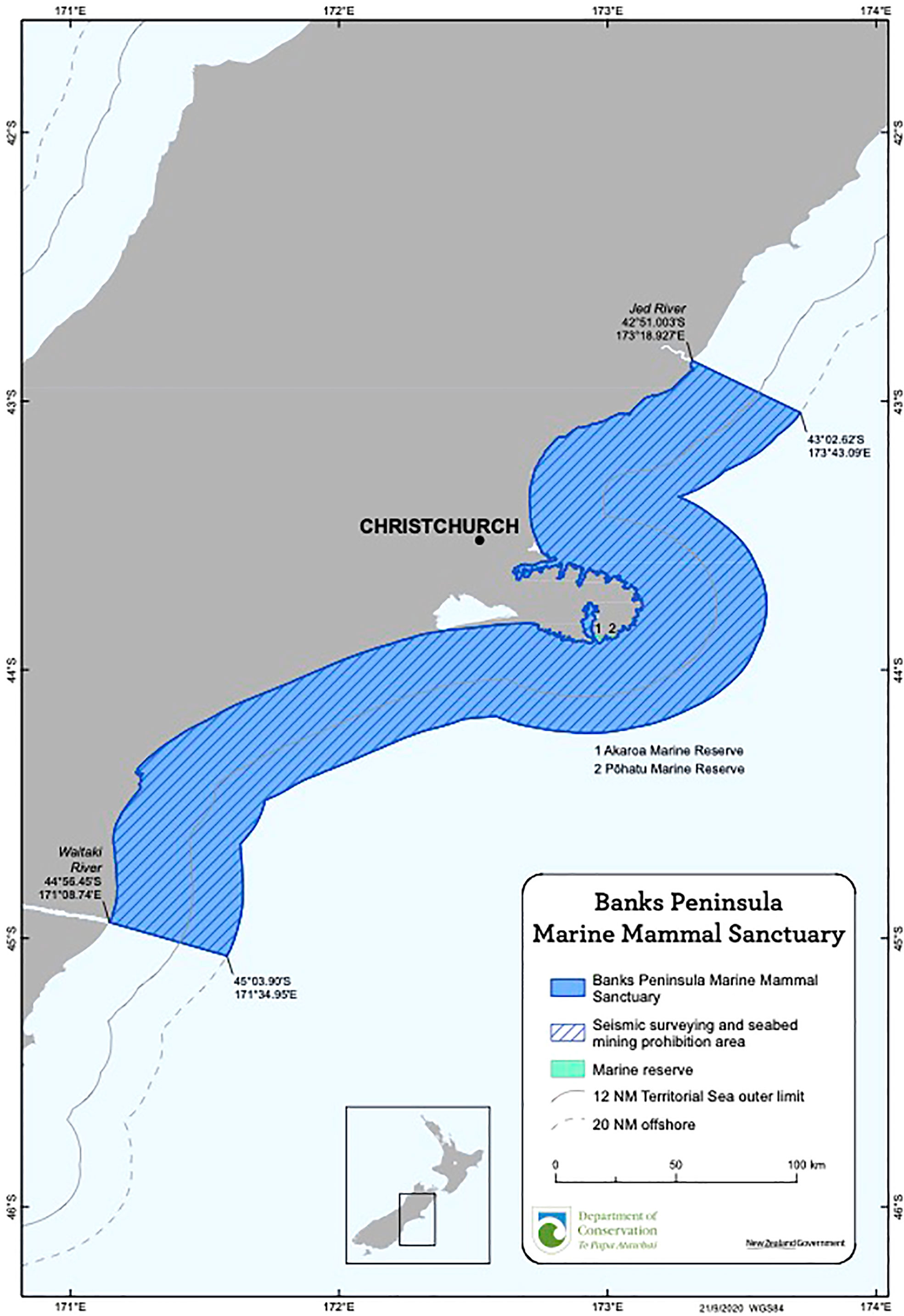
Figure 4 Map of the Banks Peninsula Marine Mammal Sanctuary. Source: Doc.govt.nz, 2021.
In the case of the Hector’s dolphin population, the study found to assess the effectiveness of the MPA in the protection of marine mammals was focused in other demographic factors rather than direct estimates of abundance. However, since the number of reliably marked individuals photographically captured during 1986–2006 was reported in the study First evidence that marine protected areas can work for marine mammals (Gormley et al., 2012), Figure 5 was created based on that data. As it can be noticed in Figure 5, there is no clear pattern in the variation of demographic abundance over the years nor a very clear differentiation between pre- and post-sanctuary periods. However, the tendency appears to be positive.
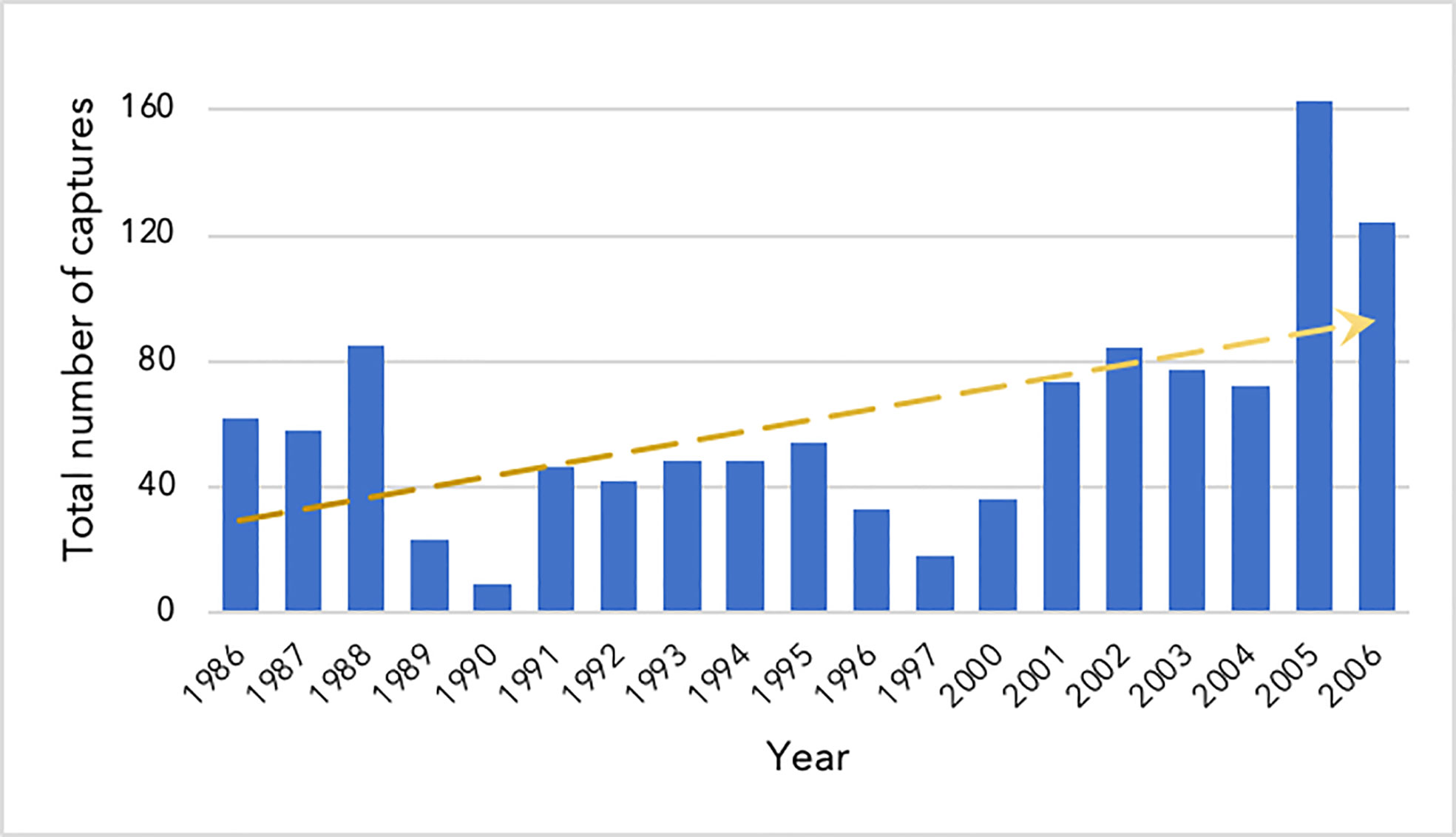
Figure 5 Hector’s dolphin count in the Banks Peninsula Marine Mammal Sanctuary. Source: Own elaboration, data amended from Gormley et al. (2012).
In order to assess the effectiveness of the MPA in the protection of marine mammals, the mean annual survival and the population growth were calculated for the pre-sanctuary and post-sanctuary periods. As it can be seen in Figures 6, both values were improved in the post-sanctuary period. According to Gormley et al. (2012), there is a 90% probability that survival improved between the pre- and post-sanctuary periods with a mean annual survival increase of 5.4% since the establishment of the sanctuary. An increase of survival of this magnitude is biologically significant with a corresponding increase in the population growth of 6%. The mean estimated annual population growth rate also had a greater change to be positive in the post-sanctuary period (41%) then in the pre-sanctuary period (7%).

Figure 6 Hector’s dolphin count in the Banks Peninsula Marine Mammal Sanctuary. Source: Own elaboration, data amended from Gormley et al. (2012).
Construction and other activities as mining and oil exploration are allowed in the MPA. However, the Department of Conservation (DOC) has established some non-mandatory guidelines for minimizing acoustic disturbance to marine mammals. Additionally, mussel farms are placed along the coastline of the MPA.
Regarding fisheries restrictions, the DOC has established some to mitigate the impacts of fishing on Hector’s dolphin, for instance, banning set netting in the Marine Mammal sanctuary (Anderton, 2008). However, it should be taken into account that set netting is the main known threat to Hector’s dolphins on that area, accounting 58% of dolphin mortalities withconfirmed cause since 1988 until it was banned in 2008 (DOC and MFish, 2007).
New Zealand’s Department of Conservation is the agency of state responsible for the sanctuary management (Hughey, 2000). However, Hector’s Dolphin Threat Management Plan is led by the DOC and the Ministry of Fisheries (MFish). The DOC is responsible for managing the dolphin populations, while Fisheries New Zealand is responsible for managing the impacts of fishing on the dolphins (Threat Management Plan for Hector's and Māui dolphin, 2022). No other bodies holding decision-making and management authority have been found.
There are five marine mammal sanctuaries along the coasts of New Zealand. All of them are placed relatively close together and were established to protect Hector’s dolphin. The DOC decided to develop a threat management plan (TMP) for the species instead of having a management plan for each MPA. An analysis of the management plan (DOC and MFish, 2007) was undertaken, revealing some missing sections, mostly in the administration component, but the goals were also very vague, whereas specific objectives were inexistent.
The DOC administers the MPA under several acts and regulations that provide a legal foundation for its adequate implementation. First of all, New Zealand is a founding member of the IWC. Moreover, the MPA is also supported by the Marine Mammals Protection Act 1978 and Marine Mammal Sanctuaries, Marine Mammal Protection Regulations 1992 (DOC and MFish, 2007).
Melville Bay is located in Greenland, was designated a Nature Reserve in 1977, and covers an area of 7,957 km² (Figure 7, DOPA Explorer, 2021). All types of hunting are prohibited except for Narwhal traditional hunting. Narwhals are subject to a small-scale regulated hunting in Greenland. The yearly quotas are established by the Minister for Fisheries, Hunting and Agriculture after consultation with Kalaallit Nunaanni Aalisartut Piniartullu Katt (The Association of Fishers & Hunters in Greenland) (Order No. 7 on conservation and hunting of beluga and narwhal, 2011).
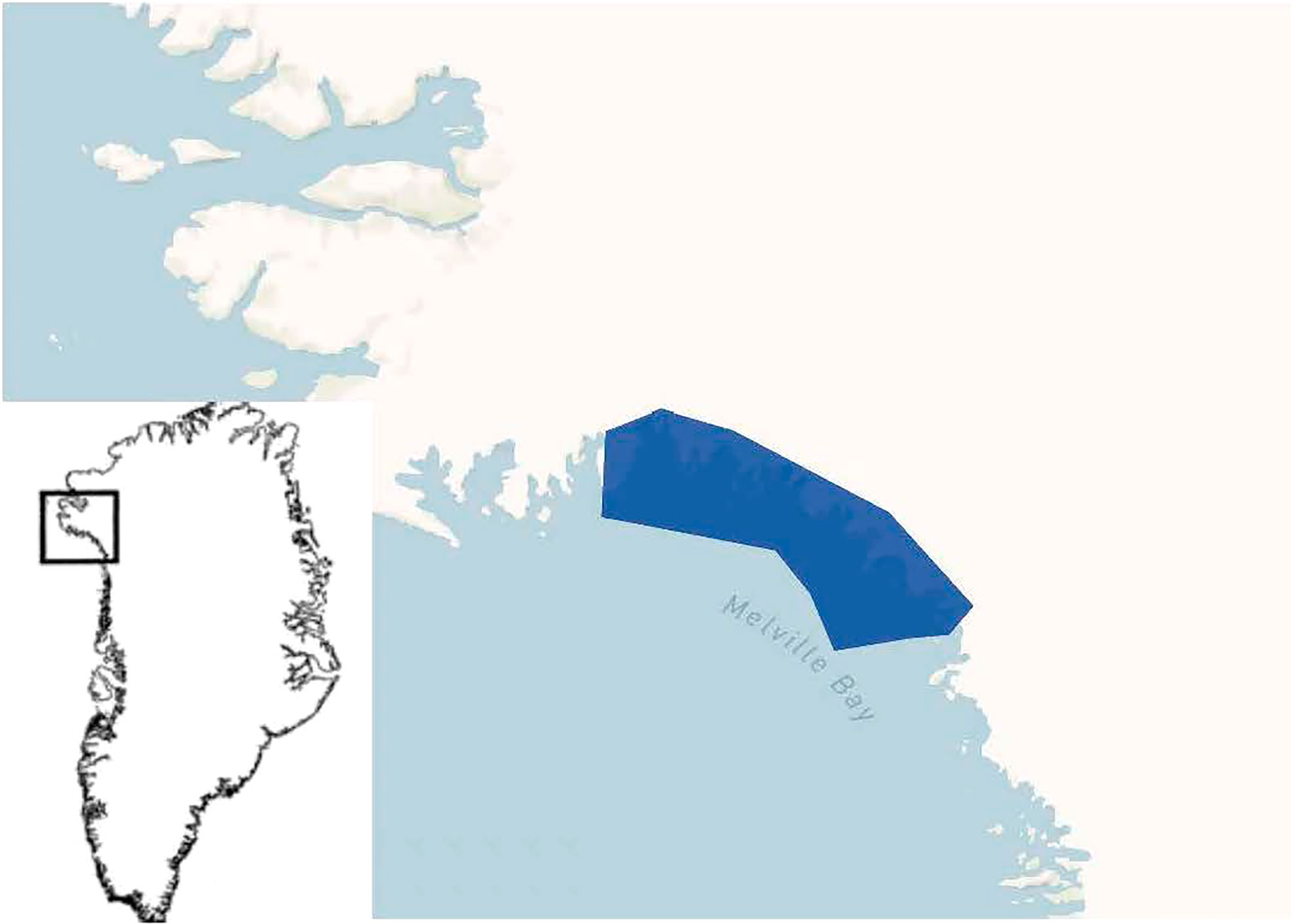
Figure 7 Map of Melville Bay. Source: UNEP-WCMC and IUCN, 2022.
Narwhal abundances were estimated from aerial surveys during summer in Melville Bay in 2007, 2012, 2014, and 2019. The abundance was 1,834 (CV = 0.92, 95% CI: 396–8,500) in 2007, 915 (CV = 0.44, 95% CI: 431–2,141) in 2012, 1,768 (CV = 0.39, 95% CI: 864–3,709) in 2014, and 4,755 (CV = 0.84, 95% CI: 1,158–20,066) in 2019. While available data suggest an increase in the abundance of narwhals in Melville Bay since 2012, it is subjected to high uncertainty in the 2019 estimate, and the observed trend is not significantly different from zero (NAMMCO-JCNB Joint Working Group, 2020). On the other hand, a posterior study on the narwhal stocks in Melville Bay highlights the difficulties on the analysis of the available data due to the highly aggregated distribution of the population, which determines high variability among random transects. A decline in the narwhals sighted in Melville Bay between 2007 and 2019 was noted, which may indicate a population decline (NAMMCO-North Atlantic Marine Mammal Commission, 2021).
The distribution of the sightings of narwhals was also studied, detecting a decrease in the area of usage of 84%, the area on a stratum level where the narwhals have been sighted has gone from 16,400 km² in 2007 to 2,610 km² in 2019. The monotonic decline in area usage may be an indicator of a population decline (NAMMCO-JCNB Joint Working Group, 2020).
A hunting analysis was carried out in Melville Bay that highlighted the increase on the hunting level in the Nature Reserve during the period of 2005–2019 (NAMMCO-JCNB Joint Working Group, 2020), sometimes even exceeding the established quota. This hypothesis can be confirmed by the NAMMCO (North Atlantic Marine Mammal Commission) catch database, which can be seen in Figure 8.
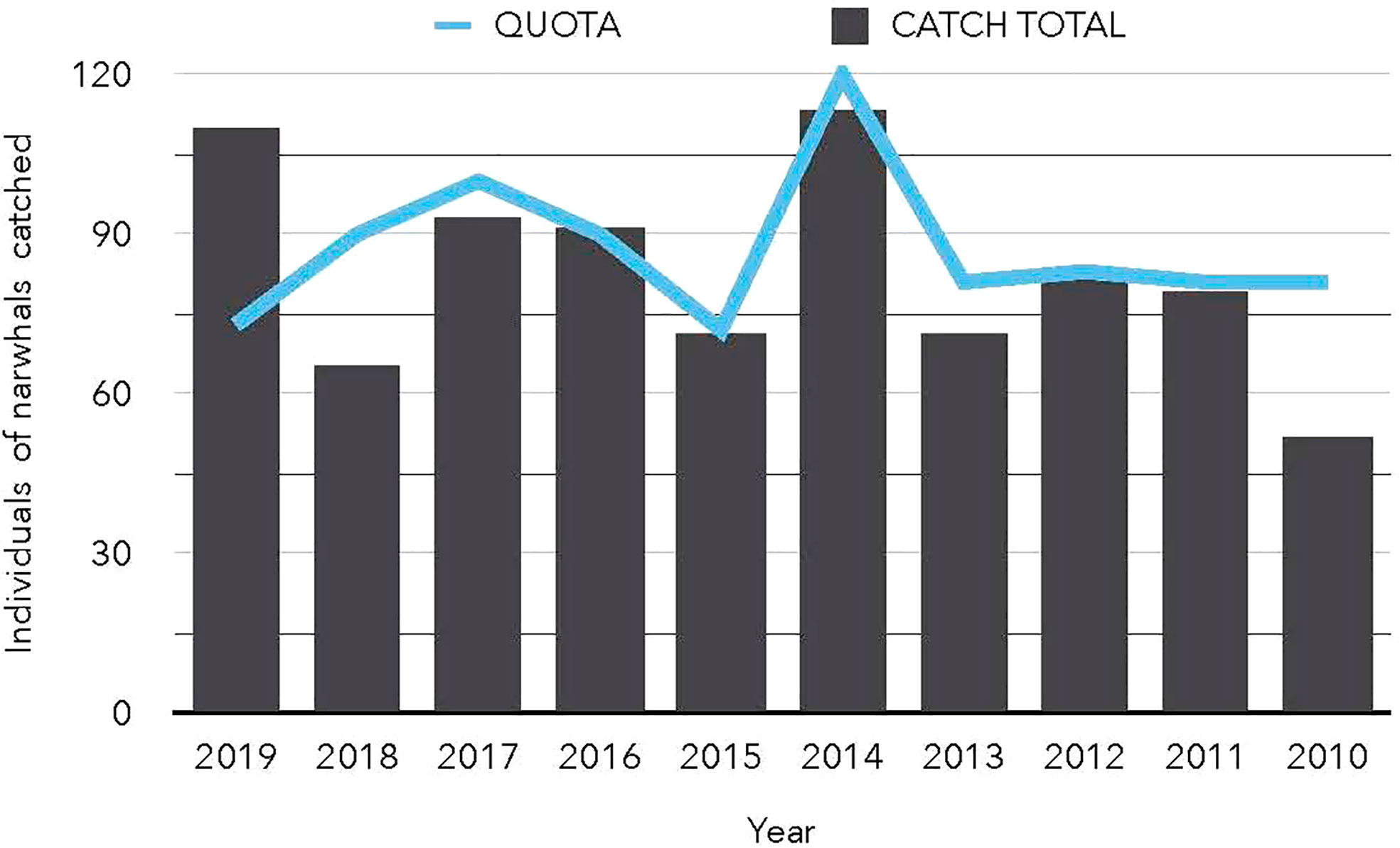
Figure 8 Total catches of narwhals in Melville Bay by year and its respective quota. Source: Own elaboration, data amended from Catch database—NAMMCO, 2021a.
Since hunting the target species is allowed in the aforementioned area, this study would designate Melville Bay as an MPA with a low or inexistent level of protection. However, it should be taken into account that fishing and hunting are inherent to the Inuit culture, being one of their most important food sources (Searles, 2002). Therefore, no marine protection of the area would ever be provided by Greenland without coexisting with the hunting of marine mammals. Perhaps, controlled hunting should already be considered as a form of protection to these species. Since the culture plays such an important role in this case, this study recommends a more in-depth assessment including the social component of the region.
Some West Greenland narwhals may travel to Canadian waters; therefore, narwhal management is a shared responsibility between Greenland and Canada. Greenland and Canada have established a bilateral management body, the Canada/Greenland Joint Commission on the Conservation and Management of Narwhal and Beluga (JCNB). The JCNB has a Joint Scientific Working Group (JWG) together with the NAMMCO Scientific Committee Working Group on the Population Status of Narwhal and Beluga in the North Atlantic. This NAMMCO-JCNB JWG provides advice at the request of the JCNB and NAMMCO, pertaining to such issues as stock delineation, total allowable catches, and threats to beluga and narwhal populations. The JCNB Commission meets periodically to receive this advice and provide management advice to Canada and Greenland (Searles, 2002).
However, concerning Melville Bay in particular, UNEP-WCMC and IUCN (2022) claim its management authority to be The Environmental Agency The Greenland Home Rule Government. Nevertheless, neither website nor official document has been found that supports this theory. Conversely, in the database of the European Commission, Melville Bay has not been reported with any management authority (Melville Bay | Dopa-explorer.jrc.ec.europa.eu, 2022).
Therefore, this study concludes that there is no clearly identifiable decision-making management body for the Melville Bay MPA. However, a designated management body does exist for the target species of the area, the narwhals.
No management plan has been found. Nonetheless, several official documents have been written where the main goals and regulations appear.
Reports in 2001, 2004, 2005, 2009, 2012, 2017, and 2020 have been written by the Joint Working Group between JCNB and NAMMCO (Scientific Working Groups - Reports - NAMMCO, 2021a). These reports discuss the abundance and distribution of narwhal and beluga, in order to adjust harvesting, in the form of annual landed catch.
General goals can be found in some publications (Nuttall, 2005; Protection of the Artic Marine Environment (PAME), 2015); however, neither specific goals nor objectives were stated.3.3.5Existence and adequacy of enabling legislation
Greenland is bound by the International Whaling Convention through the participation of Denmark. It submitted its instrument of ratification in 1950. However, the regulation of the Narwhal hunting is outside the remit of the International Whaling Commission and is entirely regulated within the Greenland Home Rule Government. Since 2004, the catches of Narwhal have been regulated quotas. In 2004, the Home Rule adopted a new executive order quota for Narwhals; the Greenland Home Rule Executive Order No. 2 of 12 February 2004 on the Protection and Hunting of Beluga and Narwhals (Fitzmaurice, 2009). The Executive Order states the annual narwhal quota.
Additionally, narwhal was added to CITES (International Convention on Trade in Endangered Species of Fauna and Flora) Appendix III, in 1977 by Greenland. Later on, in 1979, narwhals were uplisted to Annex II of the CITES. However, the regulation of the narwhal by the CITES is inconsistent and haphazard. There is neither an effective policy nor satisfactory legal measures.
Hawaiian Islands constitute one of the world's most important humpback whale (Megaptera novaeangliae) habitats. Scientists estimate that more than 50% of the entire North Pacific humpback whale population migrates to Hawaiian waters each winter to mate, calve, and nurse their young (Calambokidis et al, 2008, as cited on Office of National Marine Sanctuaries, 2010).
On 4 November 1992, the Hawaiian Islands Humpback Whale National Marine Sanctuary (HIHWNMS) was designated by the Hawaiian Islands National Marine Sanctuary Act (Subtitle C of Public Law 102-587, the Oceans Act of 1992). Encompassing 3,548 km2 of federal and state waters, the sanctuary extends from the shorelines of Hawai'i to the 100-fathom (equivalent to 183 m) isobath and is composed of five separate MPAs as illustrated in Figure 9.
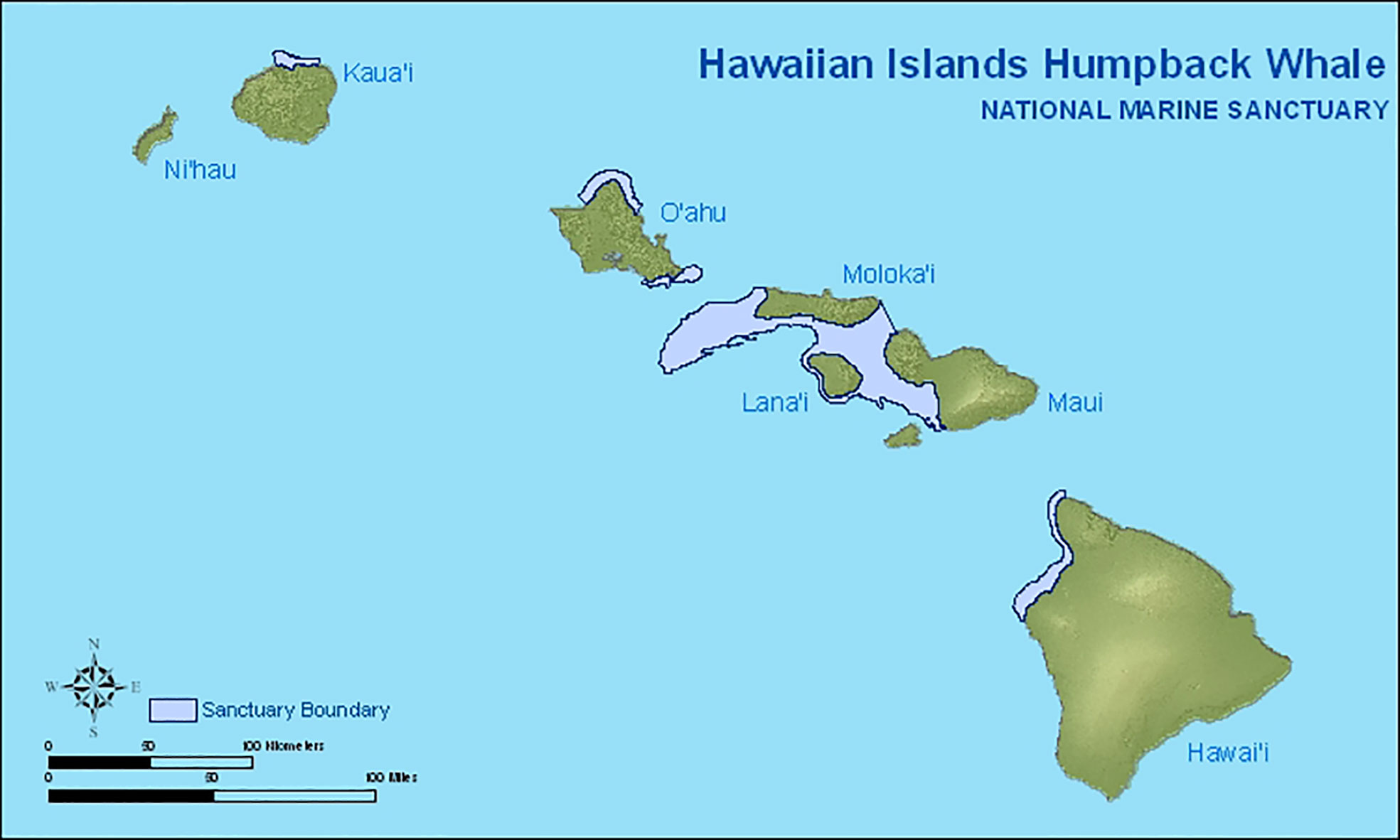
Figure 9 Map of Hawaiian Islands Humpback Whale National Sanctuary boundaries. Source: (MapsHawaiian Islands Humpback Whale National Marine Sanctuaries, 2021).
The SPLASH (Structure of Populations, Levels of Abundance and Status of Humpbacks) project was designed to determine the abundance, trends, movements, and population structure of humpback whales throughout the North Pacific. For Hawaii, three methods were used to compare estimates to determine trends. Despite the fact that absolute abundance in these estimates had certain biases, the annual rates of increase were very similar and ranged from 5.5% to 6.0% (Calambokidis et al, 2008). The primary basis for 1991–1993 estimates is from the NPAC study (Calambokidis et al., 1997, Calambokidis et al., 2001 as cited in Calambokidis et al, 2008,) with the recalculation of abundances to match samples described in Table 2.

Table 2 Estimates of annual increases in humpback whale abundance based on comparison to previous estimates.
Additionally, another study analyzed the Hawaiian distinct population segment (DPS) humpbackwhalepopulation. Thisstudyshoweda substantial population increase, where the Hawaiian DPS humpback whale population grew from 800 individuals in 1979 to more than 10,000 individuals in 2005 (Figure 10), with the population growth rate estimated to be approximately 6%. NMFS subsequently delisted it from the Endangered Species.
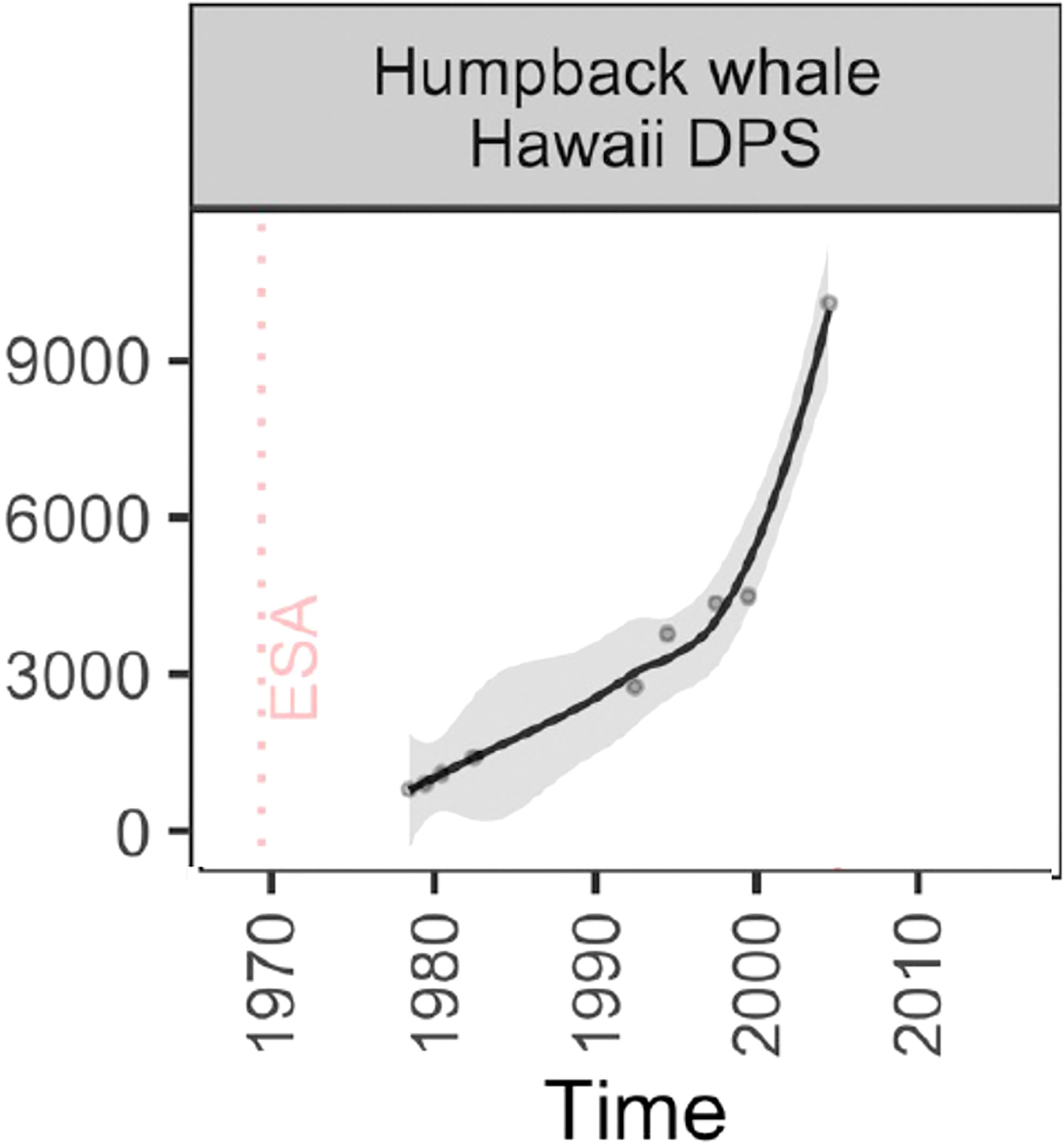
Figure 10 Population level trend on Humpback whale Hawaii DPS. Source: Valdivia et al. (2019).
Act in 2016 (NMFS, 2015 as cited in Valdivia et al., 2019).
Consecutively, a study in humpback whale abundance in Hawaii was conducted from 2001 to 2019. However, abundance was estimated as number of whales per scan instead of absolute abundance (scan meaning each observation)(Frankel et al, 2021). Nonetheless, the population trend was also estimated and can be used in the present study.
From 2001 to 2009, there was a relatively consistent increasing trend. Whale numbers peaked in 2010, with a mean count of 34 whales per scan, followed by a period of increased interannual variability lasting through 2015. Whale numbers dropped in 2016 to the lowest value since 2001 and remained low through 2019 (Frankel et al, 2021).
Extensive research on HIHWNMS regulations was undertaken in order to have a better understanding of the allowed activities within the Sanctuary.
First of all, it is forbidden to “take”, harass, harm, hunt, or shoot any humpback whale in the sanctuary (National Ocean Service, 2020). In addition, other activities are prohibited, such as dumping or dredging, together with any activity that might cause sea bed alteration, for instance, harbor expansion or nearshore construction. Moreover, sand mining and hydrocarbon exploration cannot be undertaken in the sanctuary. However, there are no restrictions on fishing activities, allowing recreational and commercial fishing in the sanctuary but always maintaining a 100-yd distance from humpback whales. Anchoring is also permitted in the sanctuary since is an activity exempted from the altering submerged land prohibition (NOS, 1997). Consequently, US HIHWNMS is minimally protected because it allows extensive fishing and anchoring (Grorud-Colvert et al., 2021).
Nowadays, the sanctuary is being managed through a cooperative federal-state partnership between NOAA's Office of National Marine Sanctuaries and the state of Hawaii through theDivision of Aquatic Resources. The decision-making body is constituted by a Sanctuary Advisory Council made up of different members that represent ocean user groups (e.g., scientists and communities). Its role is to provide advice and recommendations to the federal sanctuary superintendent. All members are appointed by the Office of National Marine Sanctuaries director in consultation with the state of Hawaii. Moreover, the council members name and role can be found on the official website of the Sanctuary.
The current HIHWNMS management plan was completed in 2020 (National Ocean Service, 2020). However, in this study, the completeness of the previous management plans has also been analyzed since the humpback whale population trend was available before 2020. The management plans have undergone successful analysis proving that they contain adequate goals and objectives in conjunction with legislative support (National Ocean Service, 2002).
Since 1995, NOAA’s National Marine Fisheries Service (NOAA Fisheries)—not the sanctuary—is responsible for the protection of whales under the U.S. Marine Mammal Protection Act (MMPA), the Endangered Species Act (ESA), the Hawaiian Islands National Marine Sanctuary Act, and the National Marine Sanctuaries Act (NMSA) (NOS, 1997). Therefore, the existence of adequate legislation has been determined to support the management of the MPA.
In order to assess MPA effectiveness in the protection of marine mammals, this study has analyzed the population trends of several marine mammal species placed in four different MPAs. The results of the recovery trends will be discussed individually to provide accurate assessment.
First of all, regarding the Wadden Sea case study, the increase in the population growth after the establishment of The Trilateral Wadden Sea Cooperation (TWSC) in 1978 suggests that the population is recovering, as can be seen in Figure 3. Previously, harbor seals were hunted until they were critically decimated in 1974 counting a population of only 3,551 animals. Nowadays, the total population of harbor seals in the Wadden Sea numbers approximately 38,126 animals (Jensen et al., 2017). Results also show a decreasing growth rate in the last few years of the survey, which could indicate that the population growth is approaching an asymptotic limit (Jensen et al., 2017). Therefore, the management and place-based conservation approach on harbor seals have resulted into a full recovery of this species in The Wadden Sea.
Concerning the second case study, the increase in annual survival after the establishment of the Banks Peninsula Marine Mammal Sanctuary suggest that the sanctuary restrictions have resulted into a reduction of Hector’s dolphin bycatch. Furthermore, the increase of survival of Hector’s dolphins, shown in Figure 6, is biologically significant, with a steady increase of their population. Therefore, this case of study shows an improvement in the demography of a marine mammal species following conservation actions (Gormley et al., 2012).
The present study does not consider Melville Bay in the effectiveness assessment on marine mammal’s protection. The governance indicators results suggest inappropriate planning, the lack of governance and poor regulation. Consequently, Melville Bay does not present the basic requirements of an MPA, such as a management plan or a decision-making management body. Since it is legally established as a protected area but is being undermanaged, not ensuring sufficient protection on the ground, it meets the conditions to be defined as a “paper park” (Dudley and Stolton, 1999; Pieraccini et al, 2016). Hence, it must not be taken into account in the assessment of effectiveness because it should not be strictly considered as an MPA.
Lastly, related to the Hawaiian humpback whale population, there is some criticism on how suitable and/or appropriate are MPAs in conserving marine highly mobile species (MHMS) (Wilson, 2016). However, several studies have highlighted the effective contribution of MPAs protecting MHMS when these are placed in critical habitats for the species survival [e.g., Pérez-Jorge et al. (2015) as cited in Kersting and Gallon (2019)].
In addition, Hawaii is well known for being a critical breeding habitat for the humpback whale individuals of the Central North Pacific population (Cartwright et al., 2012). The results of this study show a substantial recovery of the Hawaiian humpback whale population by 2005 (Calambokidis et al, 2008). In fact, The Hawaiian humpback whales were delisted from the Endangered Species in 2016 based on its strong population growth and the mitigation of key threats (NMFS, 2015 cited in Valdivia et al., 2019). These findings underscore the capacity of MHMS such as whales to recover from population declines when conservation actions are implemented in a critical breeding habitat.
However, it is also noticeable that there has been a decrease in the abundance of these species since 2016 (Frankel et al, 2021). Several experts have been hypothesizing about the declines in humpback whale numbers, but no conclusive explanation has been found yet. Nonetheless, the potential hypothesis is related to animal behavior and external environmental factors, outside of the MPA management limitations (NOAA, 2019a).
These results provide an empirical evidence of population recovery on a variety of marine mammal species following area-based protection measures. This study suggests a capacity of marine mammals to recover from population declines when place-based approaches are implemented. This assumption can be addressed in these cases studies. However, further large-scale research is necessary to validate this theory.
The indicator results were grouped into five categories depending on the evaluation outcomes; this can be seen in Table 3. This aforementioned table presents the essential data to analyze and compare the indicator results in order to justify biological effectiveness.
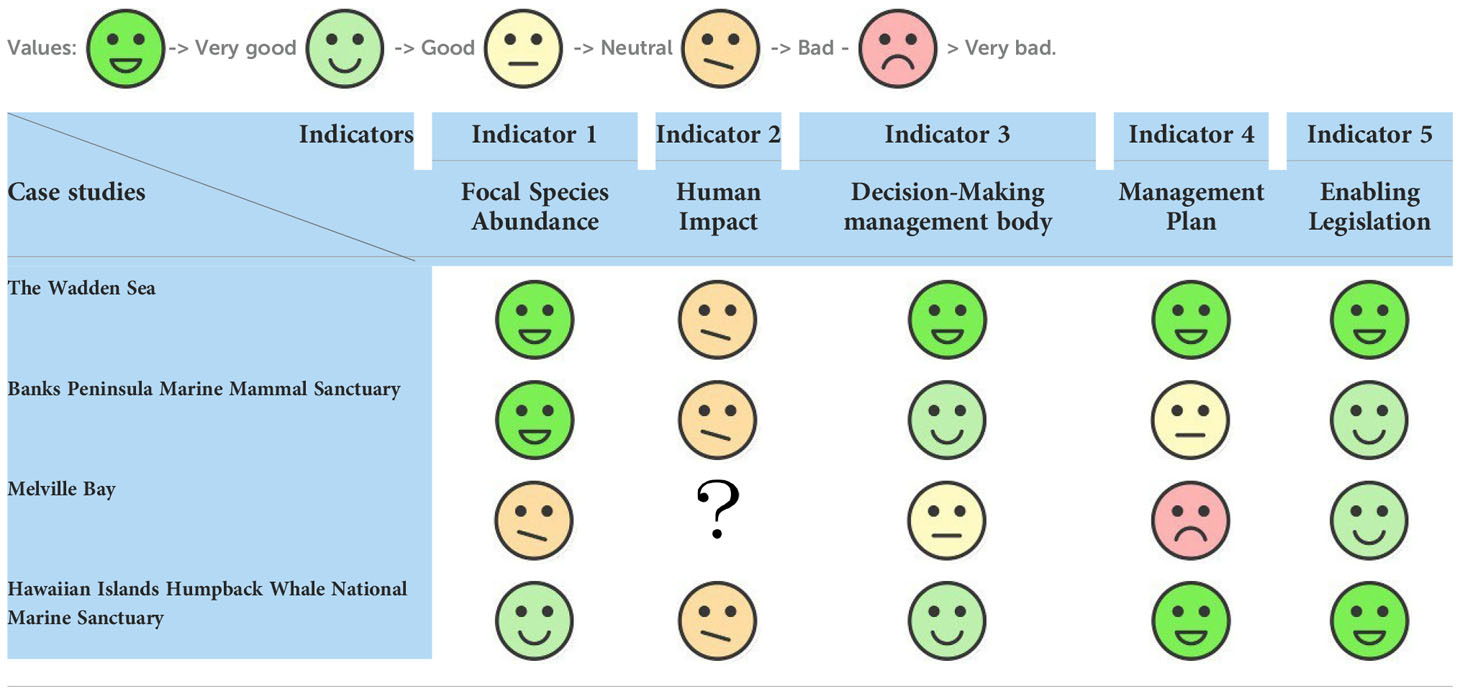
Table 3 Assessment of the indicators values for each case study, categorization based on the evaluation undertaken in Values:  -> Very good
-> Very good  -> Good
-> Good  -> Neutral
-> Neutral  -> Bad -
-> Bad -  > Very bad.
> Very bad.
First and foremost, there appears to be a parallelism between the governance indicators and the biophysical ones, which can be seen in Table 3. In fact, The Wadden Sea is a good example that biological effectiveness comes with management effectiveness. Supporting the idea that these two elements must work together as part of the same management cycle (Barragán-Muñoz, 2014; Elliott et al., 2017; García-Sanabria et al., 2021). Therefore, far from disconnected, they are interrelated. In addition, Melville Bay is a living example of theopposite. This case study shows how MPAs’ conservational goals can be jeopardized, when basic management tools as a management plan and a decision-making management body are missing.
On the other hand, in spite of the fact that HIHWNS (Hawaiian Islands Humpback Whale National Sanctuary) governance indicator results suggest effective management, the species abundance indicators do not have such a good outcome as other case studies, for instance, the Banks Peninsula Sanctuary, which has less favorable management results but a better biological outcome. This controversy supports the theory that despite management efforts, natural disturbances can radically alter ecosystems regardless of how well an area is being managed (Pomeroy et al, 2004).
Moreover, it should also be taken into account the amount of time the management measures were implemented on the different MPAs. For instance, the conservation measures on the Wadden Sea were taken since 1978 and the focal population experienced a full recovery. Future research could investigate the recovery differences on focal populations depending on time variables.
Contrarily to the governance indicators, the biophysical indicator of human impact does not suggest an association with the focal species abundance. How is possible that MPAs have good biological outcomes? Either the allowed activities do not produce an impact in the protection of the animals or the levels of protection are not well classified according to the conservational outcomes.
In the case of Melville Bay, extremely impactful activities such as hunting are being carried out. Hence, the effects of the ongoing overharvesting can be seen in the population composition (NAMMCO, 2019 as cited in Heide-Jørgensen et al., 2020) and in how the area of usage in Melville Bay has shrunk by 84% (NAMMCO-JCNB Joint Working Group, 2020). Therefore, allowed activities based on human impact can affect the biological outcomes.
Consequently, perhaps the levels of protection corresponding to the allowed activities are not being correctly evaluated. For example, The Wadden Sea was categorized as minimally protected because oil prospecting is considered incompatible with conservation and should not occur in any MPA (Grorud-Colvert et al., 2021). However, so far, high safety and environmental standards have paid off and no negative side effects to the surrounding areas have been reported (Baer and Nehls, 2017).
The precautionary principle is deeply rooted in the scientific field, being especially important in marine environment management, where scientific uncertainties abound. In its essence, the precautionary principle requires taking action in the form of protective conservation and management actions to reduce the risk of harm from an activity before negative consequences become apparent. The establishment of MPAs itself is thus a precautionary act (Antarctic Ocean Alliance, 2013). However, some respectable scientists in the marine spatial management field want to take it to a new level, recommending to focus on creating MPAs, or modifying existing MPAs, to make highly protected IUCN Category I reserves (Hoyt, 2021). In these areas, all extractive and potentially disturbing activities are prohibited. Even though these reserves provide many benefits to science, several reports show how reluctant politicians and policymakers are to them (Ballantine and Langlois, 2008).
The present study suggests that fully protected areas are not necessary to obtain noticeable biological benefits in marine mammals. Perhaps, a better approach to improve management effectiveness and meet governmental goals could be found through a more active strategy instead of implementing the precautionary principle, which might be more focused on preservation than conservation.
Alternatively, an adaptive management has a different approach when scientific uncertainty exists. Adaptive management incorporates research into conservation actions, focusing on an ongoing monitoring and evaluation of the MPA. Therefore, adaptive management enables a continuous improvement of the MPA, with its inherent uncertainty, based on a constant evaluation on the management actions.
Overall, whereas in the precautionary principle, everything is treated as threat, adaptive management approaches are context specific. Therefore, applying the adaptive management will allow us to address the exact issues and threats that affect the marine mammals leading to similar levels of protection than the fully protected areas because Category I Reserves would take everything as a threat, even what is not. Addressing issues that do not affect the species does not increase management effectiveness. On the contrary, it will lead to less financial benefits and more political resistance.
Aichi Target 11 of the Convention of Biological Diversity (CBD) promotes the expansion of the global protected area network to cover 17% of all terrestrial land and 10% of coastal and marine areas by 2020 (Convention on Biological Diversity, 2022). However, the accelerated increasing rate of protected area coverage, shown in Figure 11, could lead to have many protected areas that will be only “paper parks.”

Figure 11 Growth of the global protected area network since 1990 [source: UNEP-WCMC and IUCN 2016 as cited in UNEP-WCMC (2017)].
The effective management of protected and conserved areas is embedded in Aichi Target 11 “effectively and adequately managed.” Consequently, the Global Database on Protected Area Management Effectiveness (PAME) was developed in order to assess how well the areas are being managed (UNEP-WCMC, 2017). However, in total, only 11% of the protected areas present in The World Database on Protected Areas (WDPA) have been assessed by 2020 (UNEP-WCMC and UNEP-WCMC and IUCN, 2022).
Moreover, PAME assessments are obtained from data providers, which are entities or individuals that manage the protected areas (UNEP-WCMC, 2017). Therefore, the process of assessing management once the MPA is already accounted in the Aichi Target 11 is not common, even if one of the targets set by Parties to the CBD is to assess 60% of the total protected areas effectiveness. The clear limitation of this indicator is that it does not reveal how effectively the world’s protected areas are managed; it simply illustrates where assessments have been carried out (UNEP-WCMC and UNEP-WCMC and IUCN, 2021).
In this regard, the present study would like to highlight the necessity to better monitor the effectiveness of MPAs to avoid more cases like Melville Bay. With this purpose, future research could examine the possibility of developing a new chapter in The World Ocean Assessment (WOA) including MPAs or, even better, the first MPAs’ world assessment. This global assessment could be written by a group of experts instead of the managers itself. All protected areas present in the WDPA may be considered in the evaluation. The assessment, although not a policy document, could provide the same benefits for countries than the PAME evaluations, such as determining which management aspects are more effective, prioritizing resources where they are needed the most, and officially reporting Aichi conservation target (UNEP-WCMC, 2017). Moreover, this “tool” could be used as double- edged sword, simultaneously pressuring the governments and providing them with the scientific guidance to enhance their MPA effectiveness.
As the amount of MPAs in the world is increasing at an accelerated pace, it is important to understand the effect of these management tools in the population of protected species. By investigating the effectiveness of MPAs in the protection of marine mammals, the present study provides ample empirical evidence that area-based protection measures can be effective for different types of marine mammals. In addition, the lessons learned obtained through the outcomes of an array of different and complementary indicators showed different approaches to enhance MPAs’ overall effectiveness. On this basis, it became the need of an independent assessment for the global evaluation of MPAs’ effectiveness. Furthermore, this study suggests that an adaptive management, being context-specific, is possibly more effective than the precautionary principle. Overall, these findings provide evidence for discussion and further research on the protection of marine mammals and spatial management effectiveness.
The original contributions presented in the study are included in the article/Supplementary Material. Further inquiries can be directed to the corresponding author.
The research was done for EGT guided and supervised by JGS. All authors contributed to the article and approved the submitted version.
This publication and research has been partially granted by University of Cádiz and INDESS (Instituto Universitario de Investigación para el Desarrollo Social Sostenible), Jerez de la Frontera, CP 11405, Universidad de Cádiz, Spain.
The author declares that the research was conducted in the absence of any commercial or financial relationships that could be construed as a potential conflict of interest.
All claims expressed in this article are solely those of the authors and do not necessarily represent those of their affiliated organizations, or those of the publisher, the editors and the reviewers. Any product that may be evaluated in this article, or claim that may be made by its manufacturer, is not guaranteed or endorsed by the publisher.
The Supplementary Material for this article can be found online at: https://www.frontiersin.org/articles/10.3389/fmars.2022.940803/full#supplementary-material
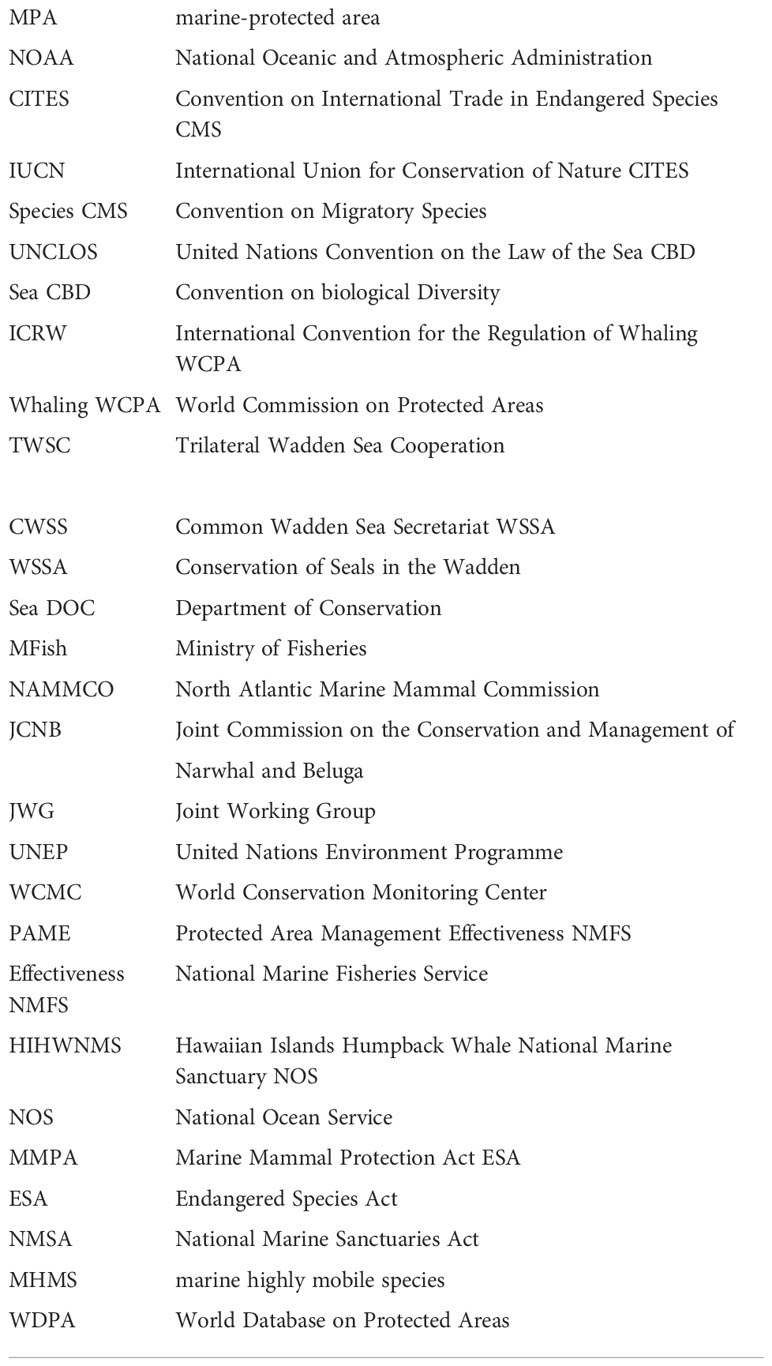
Anderton J. (2008). A range of fisheries restrictions announced by the minister of fisheries (Wellington, New Zealand: Parliament Office).
Antarctic Ocean Alliance (2013). Applying the precautionary principle to marine reserves and marine protected areas. Available at: https://www.asoc.org/storage/documents/resources/aoa-briefing-2-applying-precautionary-approach.pdf (Accessed 22 January 2022).
Avila I., Kaschner K., Dormann C. (2018). Current global risks to marine mammals: Taking stock of the threats. Biol. Conserv. 221, pp.44–pp.58. doi: 10.1016/j.biocon.2018.02.021
Baer J., Nehls G. (2017). Energy. In: Wadden Sea quality status report 2017 (Germany: Common Wadden Sea Secretariat, Wilhelmshaven).
Ballantine W., Langlois T. (2008). Marine reserves: the need for systems. Hydrobiologia 606 (1), pp.35–pp.44. doi: 10.1007/s10750-008-9347-7
Barragán-Muñoz J. (2014). Política, gestión y litoral. una nueva visión de la gestión integrada de Áreas litorales (Madrid, Spain: Editorial Tébar Flores S.L.).
Calambokidis J., Falcone E. A., Quinn T. J., Burdin A. M., Clapham P. J., Ford J. K. B., et al. (2008). “SPLASH: Structure of populations, levels of abundance and status of humpback whales in the north pacific,” in Final report for contract AB133F-03-RP-00078, 57 pp.
Calambokidis J., Steiger G. H., Straley J. M., Quinn T., Herman L. M., Cerchio S., et al. (1997). “Abundance and population structure of humpback whales in the North Pacific basin,” in Final ContractReport 50ABNF500113 (P.O. Box 271, La Jolla,CA 92038, Southwest Fisheries Science Center), 72.
Calambokidis J., Steiger G. H., Straley J. M., Herman L. M., Cerchio S, Salden D. R., et al. (2001). Movements and population structure of humpback whales in the North Pacific. Marine Mammal Sci. 17, 769–794. doi: 10.1371/journal.pone.0038004
Cartwright R., Gillespie B., LaBonte K., Mangold T., Venema A., Eden K., et al. (2012). Between a rock and a hard place: Habitat selection in female-calf humpback whale (Megaptera novaeangliae) pairs on the Hawaiian breeding grounds. PloS One 7 (5), e38004. doi: 10.1371/journal.pone.0038004
Cetaceanhabitat.org (2022) Cetacean habitat - marine protected areas. Available at: http://www.cetaceanhabitat.org (Accessed 31 January 2022).
Committee on Taxonomy (2021). List of marine mammal species and subspecies. In: Society for marine mammalogy. Available at: www.marinemammalscience.org (Accessed 21 October 2021).
Common Wadden Sea Secretariat (CWSS) (2010). Wadden Sea plan. wilhelmshaven, Germany: Common wadden Sea secretariat (CWSS) (Wilhelmshaven, Germany: Common Wadden Sea Secretariat (CWSS)). 73.
Common Wadden Sea Secretariat (CWSS) (2021). Trilateral wadden Sea cooperation. Available at: https://www.waddensea-worldheritage.org (Accessed 5 December 2021).
Common Wadden Sea Secretariat (1997). “Stade declaration,” in Ministerial council declaration of the EighthTrilateral governmental conference on the protection of the wadden Sea (Stade, Germany: Common Wadden Sea Secretariat).
Common Wadden Sea Secretariat (2010). “Sylt declaration. ministerial council declaration of the eleventh trilateral governmental conference on the protection of the wadden Sea,” in Common wadden Sea secretariat(Wilhelmshaven, Germany).
Common Wadden Sea Secretariat (2016). Implementation of the agreement on the conservation of seals in the wadden Sea. (Bonn). Available at: http://unep.org/cep/what-we-do/specially-protected-areas-and-wildlife-spaw
Convention on Biological Diversity (2022) Convention on biological diversity. Available at: https://www.cbd.int/aichi-targets/target/11 (Accessed 22 January 2022).
DOC and MFish (2007). Hector’s and maui’s dolphin threat management plan draft for public consultation (Government of New Zealand: Department of Conservation (DOC) and the Ministry of Fisheries (MFish)).
Doc.govt.nz (2021). Banks peninsula marine mammal sanctuary. Available at: https://www.doc.govt.nz/nature/habitats/marine/other-marine-protection/banks-peninsula/ (Accessed 13 December 2021).
Doc.govt.nz (2022). Threat management plan for hector's and māui dolphin. Available at: https://www.doc.govt.nz/our-work/protecting-species/protecting- marine-species/our-work-with-maui-dolphin/hectors-and-maui-dolphin-threat-management-plan/ (Accessed 12 January 2022).
Dopa-explorer.jrc.ec.europa.eu (2022) Melville Bay | DOPA explorer. Available at: https://dopa-explorer.jrc.ec.europa.eu/wdpa/4768 (Accessed 23 December 2022).
Dudley N., Stolton S. (1999). Threats to forest protected areas : summary of a survey of 10 countries carried out in association with the world commission on protected areas (IUCN).
Elliott M., Burdon D., Atkins J. P., Borja A., Cormier R., de Jonge V. N., et al. (2017). And DPSIR begat DAPSI(W)R(M)! - a unifying framework for marine environmental management. Mar. pollut. Bull. 118, 27–40. doi: 10.1016/j.marpolbul.2017.03.049
Fitzmaurice M. (2009). So much law so little protection! A case study of the protection of the narwhal. The Yearbook of Polar Law Online 1 (1), 21–54. doi: 10.1163/22116427-91000006
Frankel A., Gabriele C., Yin S., Rickards S. (2021). Humpback whale abundance in hawai‘i: Temporal trends and response to climatic drivers. Mar. Mammal Sci. doi: 10.1111/mms.12856
García-Sanabria J., García-Onetti J., Cordero Penín V., De Andrés M., Millán Caravaca C., Verón E., et al. (2021). Marine spatial planning cross- border cooperation in the ‘European macaronesia ocean’: A participatory approach. Mar. Policy (Elsevier) 132. ISSN 0308–597X. doi: 10.1016/j.marpol.2021.104671
Gormley A. M., Slooten E., Dawson S., Barker R. J., Rayment W., du Fresne S., et al. (2012). First evidence that marine protected areas can work for marine mammals. J. Appl. Ecol. 49, 474–480 . doi: 10.1111/j.1365-2664.2012.02121.x
Grorud-Colvert K., Sullivan-Stack J., Roberts C., Constant V., Horta e Costa B., Pike E., et al. (2021). The MPA guide: A framework to achieve global goals for the ocean. Science 373 (6560). doi: 10.1126/science.abf0861
Hawaiihumpbackwhale.noaa.gov (2021) Maps | Hawaiian islands humpback whale national marine sanctuaries (Accessed 23 December 2021).
Heide-Jørgensen M., Garde E., Hansen R., Tervo O., Sinding M., Witting L., et al. (2020). Narwhals require targeted conservation. Science 370 (6515), pp.416–pp.416. doi: 10.1126/science.abe7105
Horigue V., Aliño P., White A., Pressey R. (2012). Marine protected area networks in the Philippines: Trends and challenges for establishment and governance. Ocean Coast. Manage. 64, pp.15–pp.26. doi: 10.1016/j.ocecoaman.2012.04.012
Hoyt E. (2021) Benefits and pitfalls of MPAs as a conservation tool for cetaceans (Accessed 22 January 2022).
Hughey K. (2000). An evaluation of a management saga: The banks peninsula marine mammal sanctuary, new Zealand. J. Environ. Manage. 58 (3), pp.179–pp.197. doi: 10.1006/jema.1999.0309
IUCN (2021) The IUCN red list of threatened species. version 2021-2. Available at: www.iucnredlist.org.
Jensen L. F., Teilmann J., Galatius A., Pund R., Czeck R., Jess A., et al. (2017)Marine mammals. In: Wadden Sea quality status report 2017 (Wilhelmshaven, Germany: Common Wadden Sea Secretariat) (Accessed 21.12.2017).
Kelleher G. (1999). Guidelines for marine protected areas. gland: IUCN, international union for conservation of nature and natural resource (Switzerland and Cambridge, UK: IUCN, Gland), xxiv + 107pp. ISBN: 2-8317-0505-3
Kersting D., Gallon S. (2019). “MPAs and the conservation of highly mobile species,” in MedPAN(Marseille, France: MedPAN).
Magera A., Mills Flemming J., Kaschner K., Christensen L., Lotze H. (2013). Recovery trends in marine mammal populations. PloS One 8 (10), e77908. doi: 10.1371/journal.pone.0077908
NAMMCO (2021b) Scientific working groups - reports - NAMMCO. Available at: https://nammco.no/topics/sc-wg-reports/ (Accessed 23 December 2021).
NAMMCO-JCNB Joint Working Group (2020). Report of the joint working group meeting of the NAMMCO scientific committee working group on the population status of narwhal and beluga in the north Atlantic and the canada/ Greenland joint commission on conservation and management of narwhal and beluga scientific working group Vol. 2020 (Tromsø: Norway). Available at: https://nammco.no/topics/sc-wg-reports/.
NAMMCO-North Atlantic Marine Mammal Commission (2021). Report of the 27th meeting of the NAMMCO scientific committee (Tromsø, Norway: NAMMCO). Available at: https://nammco.no/topics/scientific-committee-reports/.
National Marine Fisheries Service (NMFS), National Oceanic and Atmospheric Administration (NOAA) Commerce (2016) Endangered and threatened species; identification of 14 distinct population segments of the humpback whale (Megaptera novaeangliae) and revision of species-wide listing. federal register. Available at: https://www.federalregister.gov/documents/2016/09/08/2016-21276/.
National Ocean Service (2002). Hawaiian Islands humpback whale national marine sanctuary management plan (Silver Spring, MD, NOAA).
National Ocean Service (2020). Hawaiian Islands humpback whale national marine sanctuary management plan (Silver Spring, MD, NOAA).
NOAA (2019a). “Trends in humpback whale (Megaptera novaeangliae) abundance, distribution, and health in Hawaii and Alaska: Report from a meeting held on November 27-28, 2019,” in NOAA National ocean service, office of national marine sanctuaries, Hawaiian islands humpback whale national marine sanctuary and NOAA national marine fisheries service, pacific islands regional office, protected resources division.
NOAA (2019b). Marine mammals (United States of America: NOAA National Ocean Service. Office of National Marine Sanctuaries) (Accessed 21 October 2021).
North-East Asian Subregional Programme for Environmental Cooperation (NEASPEC) (2021). North-East Asian marine protected areas network management plans, monitoring and assessment of marine protected areas (Accessed 12 November 2021).
Nuttall M. (2005). Encyclopedia of the Arctic Vol. 2010 (New York [N.Y.]: Routledge: Office of National Marine Sanctuaries).
Pérez-Jorge S., Pereira T., Corne C., Wijtten Z., Omar M., Katello J., et al (2015). Can static habitat protection encompass critical areas for highly mobile marine top predators? Insights from coastal East Africa. PloS One 10 (7), e0133265. doi: 10.1371/journal.pone.0133265
Pieraccini M., Coppa S., De Lucia G. (2016). Beyond marine paper parks? Regulation theory to assess and address environmental non-compliance. Aquatic Conserv. Mar. Freshw. Ecosyst. (Germany: Wiley-VCH Journals Support (Germany, Austria, Switzerland, Luxembourg, Liechtenstein)), 27, 177–196. doi: 10.1002/aqc.2632
Pomeroy R. S., Parks J. E., Watson L. M. (2004). How is your MPA doing? a guidebook of natural and social indicators for evaluating marine protected area management effectiveness (IUCN, Gland).
Protected Planet (2022) Explore the world's protected areas. Available at: https://www.protectedplanet.net/en/search-areas?geo_type=site (Accessed 31 January 2022).
Protection of the Artic Marine Environment (PAME) (2015). Framework for a pan-artic network of marine protected areas (Akureyri), p.33.
Reijnders P. J. H., Brasseur S. M. J. M., Tougaard S., Siebert U., Borchardt T., Stede M. (2010). Population development and status of harbour seals (Phoca vitulina) in the wadden Sea. NAMMCO Sci. Publ 8, 95–106. doi: 10.7557/3.2677
Scovazzi T. (2016). The international legal framework for marine mammal conservation in the Mediterranean Sea. Adv. Mar. Biol., 75, 387–416. doi: 10.1016/bs.amb.2016.07.006
Searles E. (2002). Food and the making of modern Inuit identities. Food Foodways 10:1-2, 55–78. doi: 10.1080/07409710212485
Selig E. R., Bruno J. F. (2010). A global analysis of the effectiveness of marine protected areas in preventing coral loss. PloS One 5 (2), p.e9278. doi: 10.1371/journal.pone.0009278
UNEP-WCMC (2017). Global database on protected area management effectiveness user manual 1.0 UNEP-WCMC (Cambridge, UK).
UNEP-WCMC and IUCN (2021)Protected planet report 2020. In: Protected planet report 2020 (Accessed 22 January 2022).
UNEP-WCMC and IUCN (2022) Protected planet: The world database on protected areas (WDPA) and world database on other effective area-based conservation measures (WD-OECM) (Cambridge, UK: UNEP-WCMC and IUCN). Available at: www.protectedplanet.net (Accessed January 2022).
United Nations Convention on the Conservation of Migratory Species of Wild Animals (Bonn). Available at: https://www.cms.int/sites/default/files/instrument/CMS-text.en_.PDF (Accessed June 23, 1979).
United Nations Convention on the Law of the Sea (Montego Bay). Available at: https://treaties.un.org/pages/ViewDetailsIII.aspx?src=TREATY&mtdsg_no=XXI-6&chapter=21&Temp=mtdsg3&clang=_en (Accessed December 10, 1982).
Valdivia A., Wolf S., Suckling K. (2019). Marine mammals and sea turtles listed under the U.S. Endangered Species Act are recovering. PloS One 14 (1), e0210164. doi: 10.1371/journal.pone.0210164
Waddensea-worldheritage.org (2021a) Organisational structure | wadden Sea (Accessed 13 December 2021).
Waddensea-worldheritage.org (2021b) Protection and management | wadden Sea (Accessed 13 December 2021).
Wilson B. (2016). Might marine protected areas for mobile megafauna suit their proponents more than the animals? Aquatic conservation: Marine and freshwater ecosystems (Germany: Wiley-VCH Journals Support (Germany, Austria, Switzerland, Luxembourg, Liechtenstein)), vol. 26, pp.3–pp.8.
Keywords: marine protected areas, management effectiveness, marine mammals, adaptive management, paper parks, case studies
Citation: Grau Tomás E and García Sanabria J (2022) Comparative analysis of marine-protected area effectiveness in the protection of marine mammals: Lessons learned and recommendations. Front. Mar. Sci. 9:940803. doi: 10.3389/fmars.2022.940803
Received: 10 May 2022; Accepted: 17 October 2022;
Published: 24 November 2022.
Edited by:
Catarina Frazão Santos, University of Lisbon, PortugalReviewed by:
Tomas Vega Fernandez, Stazione Zoologica Anton Dohrn Napoli, ItalyCopyright © 2022 Grau Tomás and García Sanabria. This is an open-access article distributed under the terms of the Creative Commons Attribution License (CC BY). The use, distribution or reproduction in other forums is permitted, provided the original author(s) and the copyright owner(s) are credited and that the original publication in this journal is cited, in accordance with accepted academic practice. No use, distribution or reproduction is permitted which does not comply with these terms.
*Correspondence: Javier García Sanabria;, amF2aWVyLnNhbmFicmlhQHVjYS5lcw==
Disclaimer: All claims expressed in this article are solely those of the authors and do not necessarily represent those of their affiliated organizations, or those of the publisher, the editors and the reviewers. Any product that may be evaluated in this article or claim that may be made by its manufacturer is not guaranteed or endorsed by the publisher.
Research integrity at Frontiers

Learn more about the work of our research integrity team to safeguard the quality of each article we publish.